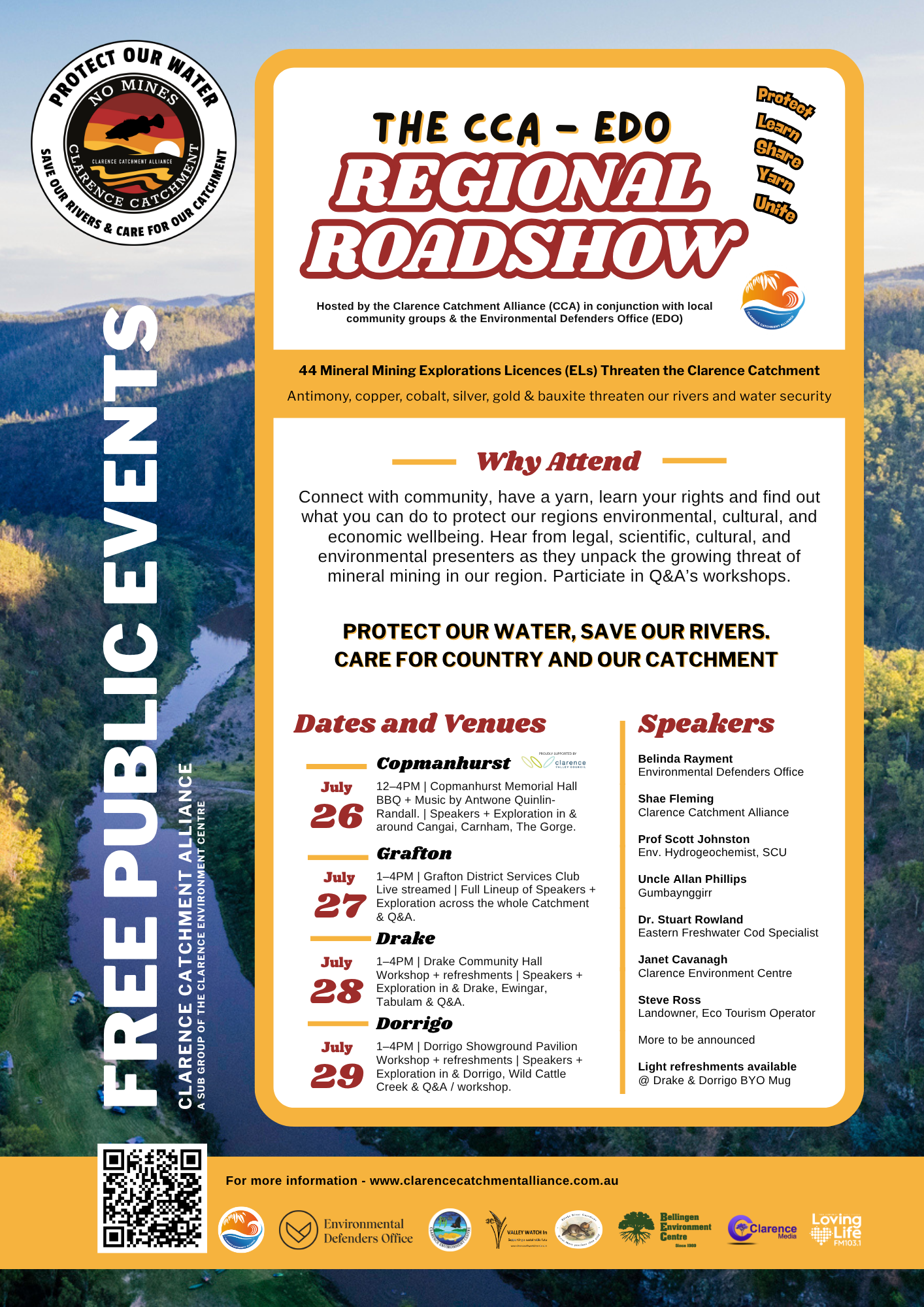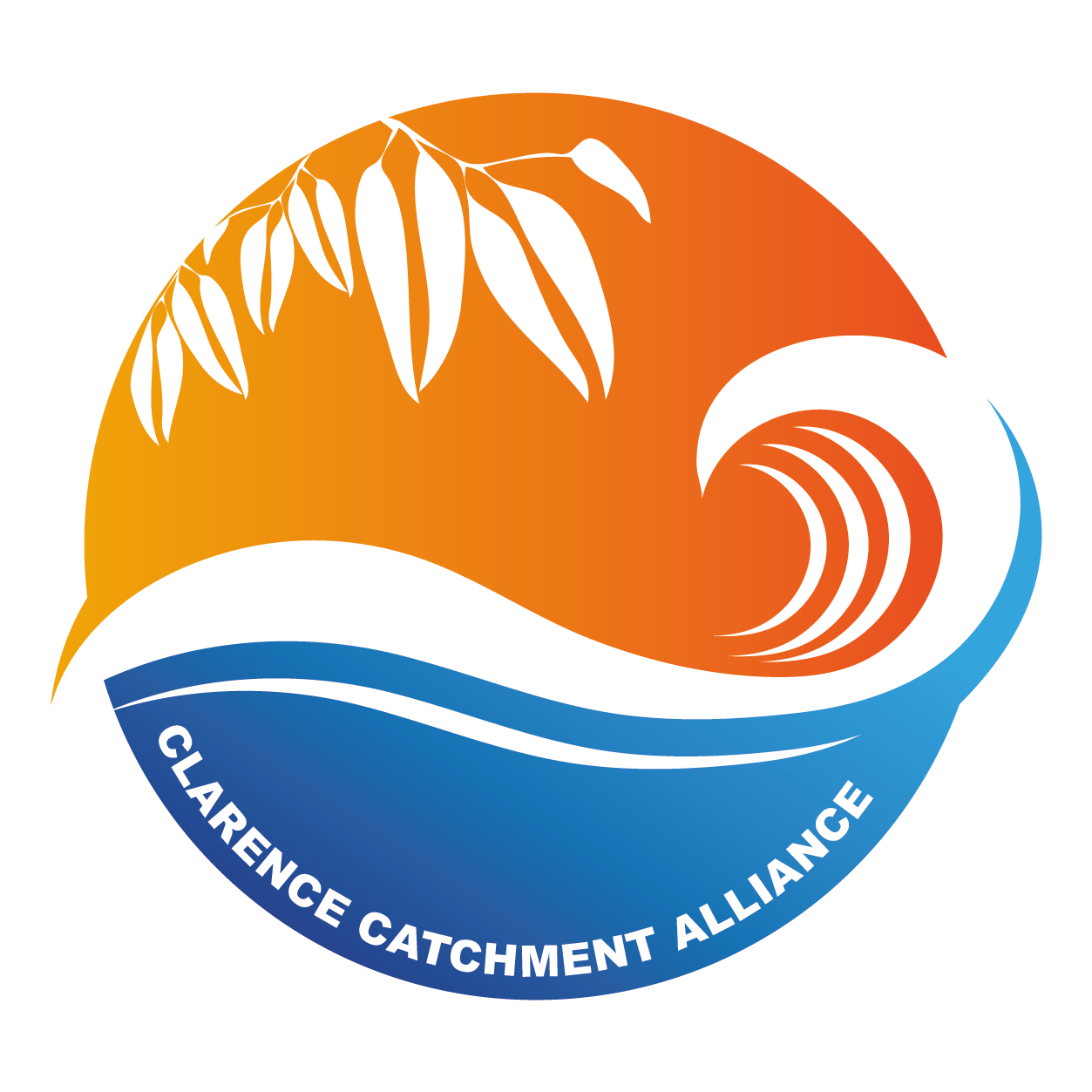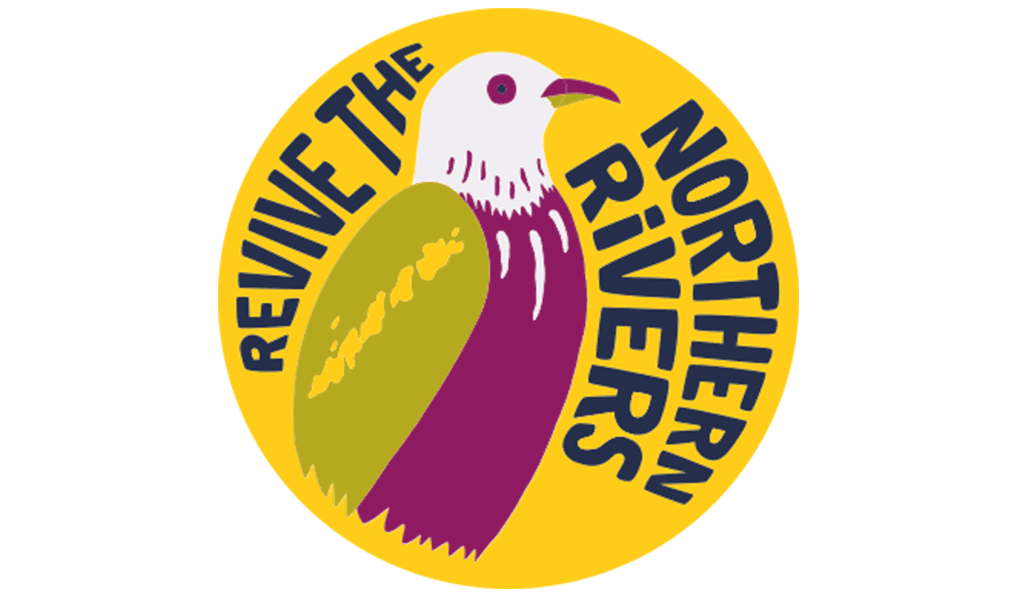
CLARENCE
CATCHMENT ALLIANCE
PROTECT OUR WATER, SAVE OUR RIVERS, CARE FOR OUR CATCHMENT.
Located in the Northern Rivers, NSW, on Bundjalung, Gumbaynggirr, and Yaegl Country.
“97% of people said healthy rivers and waterways were absolutely critical for them, followed closely by water security and maintaining habitats and biodiversity”
THE CLARENCE COMMUNITY HAS GRANTED NO SOCIAL LICENCE FOR MINERAL MINING IN OUR WATER & RIVER CATCHMENT. Survey evidence. 10,000+ signatures petition proof.
The Clarence, Nymboida, and Mann Rivers are in danger from mineral mining exploration. So is our local drinking water. Local rivers are extremely important to the health of the region’s environment, culture, community, and local industries.
High rainfall, floods, and land slips increases the risk of water contamination associated with mineral mining and exploration activities. This area has all three. When it rains toxic runoff from drill sites, processing areas and tailings dams wash down or leach into waterways and drinking water catchments. Toxins then flow to estuaries downstream to the sea. There is plenty of evidence that shows mines poison water. Evidence of cyanide runoff from the Timbarra Gold mine in the Clarence catchment from 2001 is well documented.
There are 44 mineral exploration licences (ELs) in the Clarence Catchment. On sacred Bundjalung, and Gumbaynggirr Country. If contamination was to occur that would flow though Yaegl Country.
The EL’s are beside our major rivers on unstable steep ground, including Dorrigo the major source of drinking water source for 100,000 people in the Clarence and Coffs Harbour areas. Dorrigo is a well documented extreme high rainfall, landslip zone.
Companies are searching for what are called rare earth minerals - Copper, cobalt, bauxite, silver, gold, lead, zinc and antinomy to name a few. These are used for many things including batteries and solar panels.
The most progressed exploration sites are on Mt Gilmore near the Gorge at Carnham, in Ewingar, on the Dorrigo Plateau, and in Cangai. Renewed, recent activity is occuring in the Drake region.
Click the locations to see how close they are to rivers, with steep terrain. These are high rainfall areas and flood zones meaning the risk of toxic runoff, leaks, leaching and tailings dam failure is heightened here.
The community understands that these minerals are needed, but don’t agree with mineral mining in unsuited areas such as water catchments or flood zones. These places get a lot of rain, which makes it more likely that toxic waste from mines could leak into the environment.
This could poison the water with heavy metals and other dangerous chemicals. We’re also strongly against mineral mining in areas that have high ecological and cultural significance, and areas that the existing local economy relies on. We are especially concerned with sites located where endangered animals live.
Mineral mining in the Clarence also threatens air quality, prime agricultural land, sacred sites, and causes deforestation and destruction of habitat.
Australia has had several serious cases where mine waste dams (called tailings dams) have broken. Each time, it has caused big contamination problems for the rivers and water in those areas. You can read more about it here.
Existing local industries such as agriculture, seafood, and tourism generate billions of dollars of revenue for NSW and provide mass employment for locals. They all rely on healthy environments and clean water.
The region is home to protected and endangered species such as the Australian bass, Eastern Freshwater Cod, Platypus, Koalas, and vulnerable birds like the Coastal Emu, Black-Necked Stork and Little Tern. Habitats and breeding would be severely disrupted if mines were approved.
Despite this, exploration licences (ELs) continue to be approved and some dormant mine sites are being reopened.
NSW Government rules say that mining companies must consult communities as part of the application process, to make sure the public agrees with what they’re doing. This is called gauging Social Licence. But most companies, haven’t tried to speak with our community. Some landowners haven’t been notified of explorations near their land and farms, and most haven’t responded to the CCA’s letters. Even so, the government has funded companies. Some companies are listed on the stock exchange, and are pushing ahead with their plans and boosting share prices.
We ask the NSW Government to acknowledge the lack of social licence granted by our community and the heightened risk of water contamination due to high rainfall. We want them to stop approving exploratory licences, stop renewals and revoke existing licences.
The pursuit of rare earth minerals in this delicate ecosystem not only jeopardises its natural balance but also endangers the very lifeline of the region – its water. The consequences of unchecked mineral mining activities in this area could be catastrophic, leading to irreversible damage to water quality, aquatic life, and the livelihoods and deep cultural ties of those dependent on these resources.
The Clarence Catchment Alliance (CCA) is a community lead, not for profit campaign.
It calls for mining legislation changes to protect water catchments and areas of high environmental and cultural significance, even more importantly in flood zones.
We aim to set a precedent for other communities, so our calls to the government extend beyond the Northern Rivers - to safeguard all ecologically and culturally significant water catchments from harm for the future.
Please help us protect our water, save our rivers, and care for our catchment.
CCA media coverage and campaign history can be accessed here.
FREe public events
Connect with community, have a yarn, learn your rights, and find out about the impact mineral mining has on drinking water and rivers.
Attend if you want to protect our regions environmental, cultural, and economic wellbeing.
Hear from community members, and legal, scientific, cultural, and environmental experts as they unpack the growing threat of mineral mining exploration in our region.
Participate in Q&A’s workshops.
Our Copmanhurst event will be followed by a BBQ and music by Antwone Quinlin-Randall. Refreshments are available to purchase from the club at the Grafton event, and light refreshments will be served at Drake and Dorrigo, but please BYO mug for those.
This is the clarence catchment
The Clarence River Catchment spans over 22,700 km² in northeastern NSW, stretching from the Macpherson Ranges on the QLD border through Glen Innes, Tenterfield, down to the south west boundary the Dorrigo plateau, to the coast just south of Wooli, through Yamba and Iluka to to just southwest of Evans Head. It includes major tributaries like the Mann, Nymboida, and Orara Rivers.BLUE = Mineral
BLUE = Exploration Licences (ELs) - There are 42 within the catchment
LIGHT BLUE = Mineral Exploration Licence Applications (ELAs)
The unique biodiversity of the area includes endangered, protected, and threatened species such as the Koala, Eastern Freshwater Cod, and Platypus.
The NSW government protects the Eastern Freshwater Cod and shuts down the upper Mann, Clarence, and Nymboida rivers for three months a year for spawning. The same department approves mineral mining exploration licences on the unstable, sloping land right beside them.
If mining exploration progresses to extraction these plateaus would be reduced to rubble and our water source could be poisoned by chemical and acidic runoff forever.
Mining and tailings dams pose a high risk to waterways, a problem heightened in the Clarence where steep terrain, high rainfall, and fragile geology, combine to contribute to frequent land slippages. The chances of tailings dam failure are heightened due to this.
Evidence from around the world shows the negative impact extractive industries have on waterways and catchments. Tailings dams remain forever, long after mines close and they fail, and leech into waterways. There is a greater risk of this in high rainfall, flood, and landslip zones like the Northern Rivers. This is why we are so opposed to mining here. MINES POISON WATER.
The local Timbarra gold mine did enormous damage to the Clarence River in the 90s, with cyanide contaminating waterways. It was a controversial local battle until it was finally closed. Toxic tailings dams remain, however.
Local professional fishermen remember the mutated seafood of the 70s, linked to the leaching of cyanide and other toxic substances from active gold mines at Drake in the Upper Clarence catchment.
Recent heavy rains and catastrophic floods show how quickly water moves from upriver, through our towns, and into the ocean. Steep terrain and unstable ground mean landslips are common. This highlights how risky mine tailing dams would be in this area. There is a high risk that they would overflow or fail to release contaminants into rivers.
Water is our community's common thread. We have 175+ years of heritage industries as well as more recent sectors that our local economy relies on and they are all water-reliant.
Local seafood, dairy, sugar cane, livestock, agri-food, crops, and tourism, and the industries that serve them, need clean water. No promise of mining jobs can outweigh the potential decimation of the millions of dollars and employment these sectors already provide.
CURRENT EXPLORATION LICENCES IN THE CATCHMENT
44+
Exploration Licences (ELs)
3
Exploratoration Licence Applications (ELAs)
4
Mining Leases and Gold Leases (MLs GLs)
4
Mining Purpose Leases
We demand the cancellation of current leases and a stop to new ones. Open-cut and mountain-top removal mining would destroy local plateaus, harm endangered species, and pollute nearby communities. Toxic by-products in tailings dams threaten rivers, sacred to the Bundjalung, Gumbaynggirr, and Yaegl Nations, and vital to farming, seafood, and tourism.
The risks outweigh any potential jobs.
Mining leases can be seen clearly on MinView
What we call for
The Clarence Catchment Alliance (CCA) is a grassroots, non-partisan, volunteer group dedicated to protecting the Clarence Valley’s plateaus, waterways, ecosystems, species and communities from the destructive impacts of mineral mining. The CCA operates as a sub-group of the Clarence Environment Centre.
Since 2018, the CCA have led the 'No Mines Clarence Catchment' campaign, educating, collaborating, and facilitating an avenue for community voices to be heard.
Opposing the 42 mineral exploration licences in this flood-prone region the long standing campaign has seen many successes but this is a long and difficult fight. Mining in the Clarence poses significant risks, including water and air contamination, deforestation, and destruction of endangered species’ habitats.
The CCA stands against mineral mining in this catchment because of its threats to the Clarence, Mann and Nymboida rivers, areas of high ecological significance, local culture, First Nations heritage sites, and prime agricultural land. Our water-based industries tourism, agriculture, fishing, and prawning are at risk, and no promise of mining jobs can outweigh the damage to these vital sectors. Furthermore, mining is a carbon-intensive industry that accelerates land degradation and undermines efforts to mitigate climate change.
The Clarence River, the backbone of the community’s social, cultural, environmental, and economic well-being, must be recognised as a unique living entity of high conservation value, with deep cultural and social significance. Protecting this river and its catchment is essential for safeguarding our region’s future
THE CLARENCE CATCHMENT ALLIANCE CALLS ON THE NSW GOVERNMENT TO:
Ban all mineral mining, exploratory and active in the Clarence Catchment
Cease the renewal of and revoke existing exploration licences and mining leases in areas of the Clarence Catchment (i.e. the Clarence Valley and surrounding Local Government Areas) that feed our water source, in recognition of:
-the threatened species and ecological communities found in this region, such as the Eastern Freshwater Cod and Koala
-the region's food, fishing, farming and tourism industries that are reliant on clean water, and the existing thriving economy and employment these industries create
-First Nations, cultural and community ties to the Clarence River, its major tributaries and surrounding lands
-the heightened risk of contamination due to the region's high rainfall and frequent major flooding events.
Join our calls to the Minister for Planning and Public Spaces to amend the NSW State Environmental Planning Policy (Resources and Energy) 2021 to add the following as prohibited development:
-Mineral mining and mineral exploration in all parts of the Clarence Valley Local Government Area and the Clarence Catchment's headwaters in the Coffs Harbour, Bellingen, Armidale Regional, Glen Innes Severn, Tenterfield, Kyogle and Richmond Valley Local Government Areas.
Amend the NSW Mining Act 1992 to ban mineral exploration and mineral mining occurring in major urban drinking water catchments, culturally and environmentally sensitive areas, in areas prone to flood and landslips, and across the Clarence Catchment.
A SCARY COMPARISON
These ‘what if’ images of Mt Gilmore near the Gorge, show what it might look like, before and after, if mineral mining extraction is approved. The after shots show the environmental devastation caused by the Cadia Gold Mine near Orange, NSW. Similar mining techniques would be used on Mt Gilmore if approved. Notice the similar farmland and surrounds.
Cadia contamination is found in the the community’s water, air and in residents’ blood, and livestock - caused by dam leakage and dust. Our hearts and support are with this community and we have aligned in solidarity.

We ask that our major river systemS be recognised as a unique living entities of high conservation, ENVIRONMENTAL, Cultural, social and economic value.
how you can help protect our water, save our rivers and care for our catchment
Volunteer
Please assist us with our community initiatives, help us raise funds, volunteer to sell merchandise at markets, help plan and attend our functions, help restock our CCA outlets, become an outlet for merchandise if you have a business, distribute our free front yard signs, share images to our socials or share our posts, do some researching, mapping or cultural profiling, or help us with social media. If you have time, skills, or information to share please fill in our volunteers form. We need and appreciate your assistance.
talk
Start conversations and help educate others on the threat to our environment, culture, and local economy. We have provided educational links throughout the website to help inform everyone on what is at stake. Please use and share these links and facts to start broader conversations. Please familiarise yourself with the campaign history, the six years of progress, and wonderful work done by our community. CCA media coverage and campaign information can be found here. Or join us as an official ally. Find out more.
Write
Inform decision-makers on the importance of water and rivers to our community. Help us FLOOD their inboxes with reasons they should recognise the severe threat mineral mining has on the Clarence Catchment. Please familiarise yourself with the issues and share personal stories. Putting names and faces to the potential fallout is important. Please write respectfully and passionately to the NSW Ministers listed here. We have a sample letter too to help. Find out more. Mining in flood zones is a toxic idea!

“The risk of water contamination is too high IN OUR DELICATE FLOOD PRONE AREA. Just one SPILL could poison our RIVERS AND WATER; We have way too much at stake. THE COMMUNITY HAS granted no social licenCe here.
MINING IN FLOOD ZONED WATER CATCHMENTS IS A TOXIC IDEA.”
Shae Fleming – CCA Coordinator
wearING IS carING
SHOP OUR MERCHANDISE. PROTECT OUR WATER, SAVE OUR RIVERS, CARE FOR OUR CATCHMENT.

















